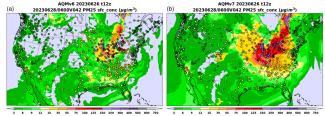The Environmental Modeling Center (EMC) at the National Centers for Environmental Prediction (NCEP), in collaboration with the Air Resource Laboratory (ARL) and the Global Systems Laboratory (GSL), Physical Sciences Laboratory (PSL) and Chemical Sciences Laboratory (CSL) under NOAA’s Oceanic and Atmospheric Research (OAR), developed an advanced regional air-quality modeling system (AQM) within the framework of the Unified Forecast System (UFS) to enhance fire-emissions representation and improve air-quality predictions. This project received funding from the Fiscal Year 2019 Disaster Supplement Program, the Disaster Relief Supplemental Appropriations Act 2022, and the Science and Technology Integration (STI) National Air Quality Forecasting Capability (NAQFC) program.
The UFS-AQM online system integrates the UFS latest atmospheric model, which utilizes the Finite-Volume Cubed-Sphere Dynamical Core (FV3) and the Common Community Physics Package (CCPP), with the embedded U.S. Environmental Protection Agency (EPA) Community Multiscale Air Quality Model (CMAQ), which is treated as a column chemistry model. Fire emissions of gasses and particulates are provided by National Environmental Satellite, Data , and Information Service (NESDIS) using Regional Hourly Advanced Baseline Imager (ABI) and Visible Infrared Imaging Radiometer Suite (VIIRS) Emissions (RAVE) fire products.
On May 14, 2024, NCEP implemented the UFS-AQM online system as an operational model (AQMv7), replacing the previous operational model (AQMv6) based on the Global Forecast System (GFS)-CMAQ offline system. The AQMv7 implementation includes the GFS version 16 (v16) physics package for physical parameterizations such as radiation, microphysics, boundary-layer turbulence, and land-surface processes. The GFSv16 physics package was originally developed under the Interoperable Physics Drive (IPD) framework for GFSv16 operational implementation in 2021. It has since been ported to the CCPP framework to support UFS-based applications.
The UFS/AQM-based AQMv7 provides more accurate numerical forecast guidance for surface ozone (O3) and particulate matter with diameters less than or equal to 2.5 micrometers (PM2.5), helping to alert vulnerable populations to avoid exposure to highly polluted air. For instance, AQMv7 predicted more realistic PM2.5 concentrations compared to AQMv6 and AirNow observations during the Quebec wildfire events in late June 2023 (Figure 1).
Additional efforts are ongoing to further improve the UFS-AQM online system's performance with the advanced CCPP at higher resolutions, addressing air-quality prediction challenges over complex terrain, coastal regions, and areas near wildfires. Assimilation of PM2.5 observations and satellite retrievals of aerosol optical depth (AOD) and nitrogen dioxide (NO2) is being developed to improve the initialization of chemical fields.
CCPP is a state-of-the-art infrastructure designed to facilitate community-wide development of atmospheric physics parameterizations, supporting their interoperability among different modeling centers, and enabling the transition of research to operations in NWP and climate modeling. The application of CCPP in the UFS-AQM online system-based AQMv7 implementation demonstrates its flexibility and utility for different UFS-based applications.
